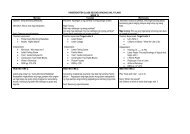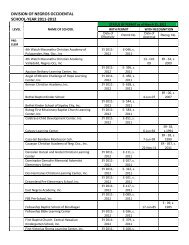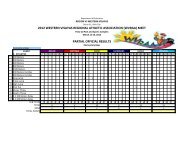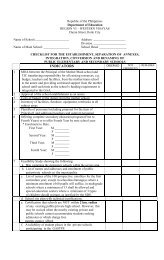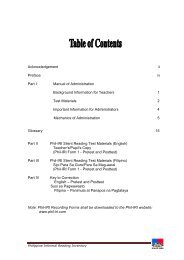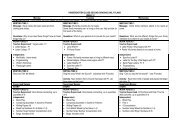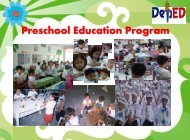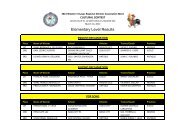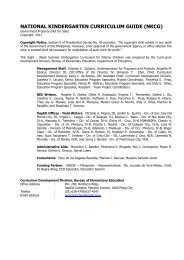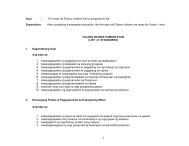5s 6s AM Class Fourth Quarter Daily Plans (sample)
5s 6s AM Class Fourth Quarter Daily Plans (sample)
5s 6s AM Class Fourth Quarter Daily Plans (sample)
Create successful ePaper yourself
Turn your PDF publications into a flip-book with our unique Google optimized e-Paper software.
KINDERGARTEN CLASS FIRST GRADING DAILY PLANS<br />
WEEK 5: ____________________<br />
Monday Tuesday Wednesday<br />
CONTENT FOCUS: I have a body. I have senses that help me learn<br />
MEETING TIME 1: MEETING TIME 1: MEETING TIME 1:<br />
Message: I use my feet to do different things. Message: I have two eyes. I see with my eyes. Message: I have two eyes. I see with my eyes.<br />
Questions: What do you think will happen if you do not<br />
have feet?<br />
Questions: What can we see around us?<br />
Questions: What will happen if you cannot see well in class?<br />
How can poor eyesight affect learning? What can you do if you<br />
have poor eyesight?<br />
WORK PERIOD 1 WORK PERIOD 1 WORK PERIOD 1<br />
Teacher-Supervised: Foot Poster<br />
Teacher-Supervised: Silly Faces<br />
Teacher-Supervised: Literature-based: What Did You See?<br />
Literature-based: Character Mask<br />
Independent:<br />
Fingerpainting: Exploration<br />
Foot Tracing<br />
Foot Printing<br />
Foot Shape Book<br />
Shape Lacing : Circles<br />
Letter Fishing Game<br />
Same and Different: Letters<br />
Writers‟ Workshop<br />
Independent:<br />
Mga Mata PEHT p. 50<br />
Mini-book: I see things around me<br />
Circle Hunt<br />
Shape Poster: Circles<br />
Shape Lacing Cards<br />
Same and Different: Letters<br />
Letter Fishing Game<br />
Independent:<br />
Shape Book: Circles<br />
Use Your Eyes PEHT p. 95<br />
Chart: Things I See at Home/ In School<br />
Spin a Bottle (colors)<br />
Writers‟ Workshop<br />
MEETING TIME 2: MEETING TIME 2: MEETING TIME 2:<br />
Message: We see round objects around us.<br />
Tula: Mata<br />
Song: Do You Know? …<br />
A circle does not have straight sides and pointed corners. Pag-usapan ang gamit ng mga mata sa tula.<br />
Questions: What round objects do you see around us?<br />
Activity: Does It Rhyme?<br />
Supervised Recess Supervised Recess Supervised Recess<br />
STORY: Nasaan ang Tsinelas Ko? STORY: Ang Mukha ni Bitoy? STORY: Si Dilat, Si Pikit, Si Kindat, Si Kurap<br />
WORK PERIOD 2: WORK PERIOD 2: WORK PERIOD 2:<br />
Teacher-Supervised: Scrapbook Teacher-Supervised: Mixed Up Numbers Teacher-Supervised: Ribbon Me<br />
Independent::<br />
Block Play<br />
Playdough<br />
Bead stringing<br />
Number Stations/ Number Books<br />
It‟s a Match<br />
Number Concentration (0-3)/ Number Lotto (0-3)/<br />
Fishing Game: Numbers (0-3)/ Bingo: Numbers (0-3)/<br />
Number Snap (0-3)<br />
Independent::<br />
Block Play<br />
Playdough<br />
Bead stringing<br />
Number Stations/ Number Books<br />
Writing Papers (2)<br />
Number Concentration (0-3)/ Number Lotto (0-3)/<br />
Fishing Game: Numbers (0-3)/ Bingo: Numbers (0-3)/<br />
Number Snap (0-3)<br />
Independent::<br />
Block Play<br />
Playdough<br />
Number Stations/ Number Books<br />
Writing Papers (2)<br />
Mixed Up Numbers<br />
Number Concentration (0-3)/ Number Lotto (0-3)/ Fishing<br />
Game: Numbers (0-3)/ Bingo: Numbers (0-3)/ Number<br />
Snap (0-3)<br />
INDOOR/OUTDOOR ACTIVITY: People Counting<br />
INDOOR/OUTDOOR ACTIVITY: Let‟s See PEHT p. 48 INDOOR/OUTDOOR ACTIVITY: Circle Game<br />
Games: Hopping Forward and Bouncing Ball (1, 2, 3)<br />
MEETING TIME 3: Dismissal Routine MEETING TIME 3: Dismissal Routine MEETING TIME 3: Dismissal Routine<br />
1
THURSDAY FRIDAY NOTES<br />
CONTENT FOCUS: I have a body. I have senses that help me learn.<br />
MEETING TIME 1: MEETING TIME 1:<br />
Tula: Pandinig<br />
Message: I have 2 ears. I hear with my ears.<br />
Message: I have 2 ears. I hear with my ears.<br />
Questions: What sounds can we hear?<br />
Questions: What will happen if you cannot hear well in<br />
school? At home? What do some sounds mean? (ex. sirens,<br />
bells)<br />
WORK PERIOD 1 WORK PERIOD 1<br />
Teacher-Supervised: Sensory Walk: Listening to Sounds Teacher-Supervised: Poster: What objects make sounds?<br />
Around Us<br />
Poster: Sounds We Hear In School<br />
Independent:<br />
Finger painting Exploration<br />
Spin a Bottle (colors)<br />
Sound tracks<br />
Sound Cans<br />
Color Memory Game<br />
Letter Fishing Game<br />
Senses PEHT p. 47-48<br />
MEETING TIME 2: MEETING TIME 2:<br />
Activity: Making Sense of Sentences<br />
Supervised Recess<br />
STORY: Ang Banda ni Manda<br />
Independent:<br />
Finger painting Exploration<br />
Sound cans<br />
Ear Book: I can hear different sounds<br />
Toss a Rubber (colors)<br />
Color Memory Game<br />
Writers‟ Workshop<br />
Message: Some sounds are high and some are low.<br />
Some sounds are soft and some are loud.<br />
Activity: Sound Trip: Two Little and Ikot-ikot<br />
Supervised Recess<br />
STORY: Ang Kuya ni Karina<br />
WORK PERIOD 2: WORK PERIOD 2:<br />
Teacher-Supervised: Matching Lids with Boxes<br />
Teacher-Supervised: Fruit and Vegetable Patterns<br />
Independent::<br />
Independent::<br />
Matching Lids with Boxes<br />
Matching Lids with Boxes<br />
Number Stations/ Number Books<br />
Number Stations/ Number Books<br />
Number Concentration (0-3)/ Number Lotto (0-3)/ Fishing Number Concentration (0-3)/ Number Lotto (0-3)/ Fishing<br />
Game: Numbers (0-3)/ Bingo: Numbers (0-3)/ Number<br />
Game: Numbers (0-3)/ Bingo: Numbers (0-3)/ Number<br />
Snap (0-3)/ Mixed Up Numbers (0-3)<br />
Snap (0-3)<br />
INDOOR/OUTDOOR ACTIVITY: Where‟s the Sound?<br />
INDOOR/OUTDOOR ACTIVITY: Here I Am<br />
MEETING TIME 3: Dismissal Routine<br />
MEETING TIME 3: Dismissal Routine<br />
2
APPENDIX: WEEK 5<br />
A. THEME-RELATED ACTIVITIES<br />
Foot Poster: We use our feet to do different things.<br />
Objectives: tracing<br />
Number of Players/Participants: 6-8 students<br />
Materials. construction paper or bond paper, scissors, glue, manila paper<br />
Procedure:<br />
1. On each foot cut-out, have a child draw/write about one thing he/she can do using her feet e.g. dance, climb, jump<br />
2. Have children paste their drawings on the manila paper.<br />
3. Write the title “We use our feet to do different things.”<br />
Foot Tracing<br />
Objectives: tracing<br />
Materials. construction paper or bond paper, scissors, glue, manila paper<br />
Procedure:<br />
1. Give each a child a piece of paper.<br />
2. Have him trace his foot on it.<br />
3. Teacher cuts this out.<br />
4. Ask children to glue their hand cut-out on manila paper.<br />
Foot Print<br />
Materials: paint, water, tissue paper, manila paper<br />
Number of Players/Participants: 8 children<br />
Procedure<br />
1. Dilute paint in water.<br />
2. Pour a small amount of this on a small basin.<br />
3. Put tissue paper on the basin. (This will prevent the paint from splashing once the children start dipping their foot into the<br />
paint.<br />
4. Have each child dip his foot into the paint then let him stamp this on the manila paper.<br />
5. Ask the child to label her foot.<br />
6. Write the title “ This my footprint !! “<br />
Foot Shape Book<br />
Objectives: identify things we can do with our feet<br />
Materials: 6-8 pages of ½ crosswise paper, pencils, crayons, stapler (Teacher writes the title on each of the booklets.)<br />
Number of Players/Participants: 8 children<br />
Procedure:<br />
Teacher traces the footprint of each child and cuts out at least 6-8 pages of that footprint. She staples the pages<br />
together.<br />
Let the children write their name on the cover page of the booklet.<br />
ON each page of the booklet, have them draw things that they can do with their feet..<br />
Take down dictation as needed.<br />
Silly Faces<br />
Objectives: To identify the different parts of the face<br />
Materials: big cut-out circle from a white paper, old magazines, scissors, paste/glue<br />
Number of Players/Participants: 8 children<br />
Procedure:<br />
1. Look for the different facial features in the magazines and cut them out.<br />
2. Paste them on the white paper to form a face.<br />
Mini-book – I can see many things around me.<br />
Objectives: To identify and describe the things in the environment<br />
Materials: mini-books, pencil, crayons, paste/glue,<br />
Participants: 8 children<br />
3
Procedure:<br />
1. Distribute the booklets to each child.<br />
2. On the first page, have the child draw objects of different colors.<br />
3. On the second page, let the child draw objects of different shapes.<br />
4. On the third page, let the child draw objects of different sizes.<br />
5. Take down dictation as needed.<br />
Mga Mata PEHT p.50<br />
Use your eyes PEHT p.95<br />
Senses PEHT p.47-48<br />
Chart: Things I See at Home/In school<br />
Objectives: to identify things in the environment<br />
Materials: ½ bond paper or pad paper<br />
Number of Players/Participants: any number<br />
Procedure:<br />
1. Ask each child to make a chart like the one below. On the left column, have HIM write “ HOME” and on the other<br />
column, have him write “SCHOOL”<br />
HOME<br />
SCHOOL<br />
2. Have him/her draw things that he/she sees at home and in school on the respective columns.<br />
Sound cans<br />
Objectives: To match identical sounds<br />
Materials: yakult bottles(cover it with art paper), or yogurt cups, a little amount of sand, mongo seeds,stones, bottons,<br />
Preparation: Prepare sound cans using yakult bottles. For each pair of bottles, put in a particular object/objects that<br />
make a sound.<br />
e.g. mongo seeds, sand, pebbles<br />
Participants: 8 children<br />
Procedure:<br />
1. Ask a child to shake a bottle and guess what is inside.<br />
2. Then have him look for a bottle that matches with the one he is holding.<br />
3. After he has found one, let another child do the same thing.<br />
4. Activity continues until everyone has tried finding a match.<br />
Sound tracks<br />
Objectives: To identify environmental sounds<br />
Materials: tape recorder (Teacher will record different sounds e.g. doorbell, telephone, clap, etc.)<br />
Preparation: Teacher records different environmental sounds e.g. animal sounds, bell, dripping of water,<br />
telephone/cellphone<br />
Participants: 8 children<br />
Procedure:<br />
1. Teacher plays the recorder.<br />
2. Children listen to a particular sound and identify what it is.<br />
3. After the activity, have children draw things that make sounds.<br />
Sensory Walk – Listening to sounds around us<br />
Objectives: To identify the different sounds around us<br />
Materials: notebook and pen for Teacher‟s use only (Teacher brings a notebook and pen to take down notes of the things that the<br />
children will see).<br />
Number of Players/Participants: 8 children<br />
Procedure:<br />
1. Teacher tells the children that they are going on a listening walk.<br />
4
2. Ask this question “What body part do we need to be able to listen to the sounds around us?” Remind the children to<br />
refrain from talking to be able to hear the sounds very well.<br />
3. Walk around the school and stop at certain spots where there are distinctive sounds – children shouting, music playing,<br />
etc.<br />
4. Teacher asks them what they can hear around them.<br />
5. Teacher takes note of their answers. This list will be used in other activities.<br />
Poster : Sounds We Hear In School<br />
Objectives: To differentiate the different sounds around us<br />
Materials: manila paper, scratch papers, pencil, crayons, paste/glue<br />
Participants: 8 children<br />
Procedure:<br />
1. Ask the children to recall the things they heard when they went around the school.<br />
2. Give each chil d a piece of paper and ask him to draw his answer<br />
3. Take down dictation as each child tells you what he drew or you can sound out the letters while guiding him how to write<br />
the letters.<br />
4. Paste their answers in the manila paper. Write the title of the activity.<br />
Ear Book: I can hear different sounds<br />
Objectives: To differentiate the different sounds around us<br />
Materials: shape booklets (ear shape) , markers, crayons, pencils<br />
Participants: 8 children<br />
Procedure:<br />
1. On each page, ask children to list down things that make sounds in the environment.<br />
2. Take down dictation as needed.<br />
3. Write the title “ I can hear different sounds. “<br />
B. OTHER MATH ACTIVITIES<br />
Circle Hunt<br />
Objectives: to identify round objects in the environment<br />
Materials: several square objects, 1/8 manila paper, ¼ newsprint or bond paper, glue, crayons or markers<br />
Number of Players/Participants: 8 children<br />
Procedure:<br />
1. Tell children to look for triangular objects in the classroom.<br />
2. Ask children to identify the objects that they found.<br />
3. Have them draw the round objects in small strips of paper.<br />
4. Paste these on 1/8 Manila paper.<br />
5. Write the title “ There are round objects around us. “<br />
Shape Lacing: Circle<br />
Objectives: shape recognition; eye-hand coordination<br />
Materials: pre cut circle shape cardboard, puncher, yarn<br />
Participants: 8 children<br />
Procedure:<br />
1. Distribute the shape cards.<br />
2. Using the yarn attached to the shape card, have each child lace the edges of the shape card he is holding.<br />
Shape Book: Circles<br />
Objectives: shape recognition<br />
Materials: shape booklets (round) , pencil, crayons or markers<br />
Number of Players/Participants: 8 children<br />
Procedure:<br />
Ask children to draw round objects they know of in their individual booklets<br />
Let them label their drawings.<br />
Have them design the cover of their booklets.<br />
5
Shape Poster: Circles<br />
Objective: to recognize shapes<br />
Materials: ¼ manila paper , strips of paper ( 1/8 of bond paper)<br />
Number of players/participant: 6-8 participants<br />
Procedure:<br />
1. Draw the shape on top of the page. Then write the title, “I see round objects around me .“<br />
2. Ask each child to draw round objects that they see around them. Start with the ones in the classroom.<br />
3. Children name the objects in the poster.<br />
4. Children stick their drawings into the manila paper.<br />
5. Teacher presents their poster to the whole class during Meeting time 2.<br />
Color Memory Game<br />
Objective: to identify color cards<br />
Material : 6-8 pairs of color cards<br />
Number of players/participant: 4-6<br />
Procedure:<br />
1. Place all cards on the table face down.<br />
2. Each player turns over two cards during his turn. If he gets a pair of identical color cards, he gets to keep the pair and<br />
takes another turn.<br />
3. If the color cards do not match, the player puts back the cards into their original place.<br />
4. The player who is able to get the most number of pairs wins the game.<br />
Toss the Rubber (colors)<br />
Objectives: color recognition<br />
Materials: rubber band, color cards<br />
Number of Players/Participants: 8 children<br />
Procedure:<br />
1. Scatter color cards on the floor.<br />
2. Children take turns in tossing the rubber band.<br />
3. Have them identify the color of the card on which the rubber band landed.<br />
Spin the Bottle (colors)<br />
Objectives: color recognition<br />
Materials: mineral water bottle, color cards , color graph<br />
Number of Players/Participants: 8 children<br />
Preparation:<br />
Make a graph like the one below:<br />
How many times did it land on …. ?<br />
RED BLUE YELLOW<br />
Procedure:<br />
1. Arrange the color cards around the circle.<br />
2. At each turn, a child spins the bottle.<br />
3. Have the child identify the color of the card to which the top part of the bottle is pointing to.<br />
4. Let them record how many times the spinner landed on a particular color by drawing sticks on each<br />
column.<br />
Color Fishing Game<br />
Objectives: to identify colors<br />
Materials: colored fish, fishing rod<br />
Number of Players/Participants: 2-6 children<br />
Procedure:<br />
1. Children take turns using the fishing rod to “catch” a fish.<br />
2. Ask each child to name the color of the fish that he/she catches at each turn.<br />
3. At the end of the game, have them record on paper how many of each color were they able to catch.<br />
6
Scrapbook<br />
Objective: to classify objects based on a given attribute<br />
Number of Players/ Participants: 6-8<br />
Materials: old magazines Manila paper scissors glue/paste<br />
Preparation: Make a scrapbook by binding ¼ sheets of Manila paper<br />
Procedure:<br />
1. 1.Cut out pictures from old magazines, newspapers and catalogues.<br />
2. Make a scrapbook divided up into different categories such as animals, cars, food, people (girls/ boys or adults/<br />
children). You could also incorporate numbers.<br />
Matching Lids With Boxes<br />
Objective: to notice size, shape of various boxes<br />
Number of players/ Participants: 4<br />
Materials: boxes of various sizes and shapes (with and without lids or covers)<br />
Procedure:<br />
Teacher supervised:<br />
1. To help children focus their attention on the geometric attributes of boxes, begin by saying such things as, “I see a<br />
square on this box. Do you see any other boxes that have square faces? Or “I see this box has two long rectangles<br />
and two short rectangles. Do you see any other boxes that have those kinds of faces?” Or “What do you notice about<br />
the boxes?”<br />
2. Pick up one box and ask, ‟Which of those lid can be used to cover this box?”<br />
Independent work:<br />
1. Give the children several boxes of various sizes and shapes<br />
2. Ask the children to match the boxes with their lids or covers.<br />
3. Discuss with the children how they knew which boxes and lids went together<br />
Ribbon Me<br />
Materials: a reel of ribbon, scissors, Manila or kraft paper, glue, pencil<br />
Procedure:<br />
Use lengths of ribbons to measure the different parts of the body<br />
Make a Ribbon Me chart that will show all the measurements of one child.<br />
foot ankle wrist waist forearm neck nose mouth<br />
<br />
A Ribbon Me chart can also show the measurements of the wrists of all children.<br />
Note: It is always important to note that all ribbons should start at the same base line so that the children do not get<br />
fooled by what they see.<br />
Fruit and Vegetable Patterns<br />
Objective: to describe patterns<br />
To connect an abstract idea to the real world<br />
Number of Players/ Participants: 6-8<br />
Materials: variety of fruits and vegetables such as onion, orange, apple, banana, cabbage<br />
Bond or scratch paper pencil crayon<br />
Procedure:<br />
1. Have the children look outside each piece of fruit or vegetable. Encourage them to describe the shape, texture and<br />
markings.<br />
2. Ask the children questions to force them to examine each piece carefully: Which is green? Yellow? Orange? Which ones<br />
are smooth? Bumpy? Which ones pull apart? Which one feels like paper? Which ones have tiny spots on the skin?<br />
3. Ask the children to draw each item<br />
4. Ask the children what they think each fruit or vegetable looks like inside. Ask them to predict if these would have the<br />
same color on the inside. Ask if they expect to find seeds – few or many. Discuss the lines, the shade of color.<br />
7
5. Cut each item open and talk about what you discover. Look at the different patterns in each piece.<br />
6. Ask the children to draw what they see in the inside.<br />
Writing Papers (2)<br />
Objective: to learn sequence<br />
To observe the form of each numeral<br />
To develop eye-hand coordination<br />
Materials: writing papers (with number dot patterns for each numeral)<br />
crayon<br />
Number of participants: individual<br />
Procedure:<br />
Each child is given a writing paper with the numeral he is working on, in this case 2.<br />
Children use a crayon to connect the dots of the number pattern.<br />
Mixed Up Numbers<br />
Objectives:<br />
To read and recognize number words<br />
To recognize the sequence of numbers<br />
Players: small group<br />
Materials: vocabulary cards of number words<br />
ONE<br />
TWO<br />
1. Place the word cards at random in the chalk tray.<br />
2. Ask the students to say each word with you.<br />
3. Ask the children to help you place them in correct sequence.<br />
4. Tell the children to hide their eyes while a mischievous kitten (you) comes and change the order of the cards.<br />
5. The children close their eyes and lower their heads on their desk.<br />
6. The teacher switches cards and then calls on a pupil to return them to the correct places.<br />
THREE<br />
Variation: Distribute the cards to the children. Call one of the word names. A student with the corresponding card is invited<br />
to stand.<br />
Number Stations (quantities of 3)<br />
Objectives: To count up to quantities of 3<br />
To see that despite differences in appearance quantities remain the same (conservation)<br />
To develop fine motor coordination<br />
Materials: assorted materials such as pebbles, popsicle sticks, old keys<br />
Number of Players/Participants: 8 children<br />
Procedure:<br />
1. Teacher chooses a number to work with for the day, in this case 3.<br />
2. Children work together exploring a given quantity of objects, in this case 3, making as many arrangements as possible.<br />
Then let the children write the number on their paper.<br />
3. Teacher encourages the children to describe the patterns in a variety of ways.<br />
Number Books (quantities of 3)<br />
Objectives: To use numerals to describe and record quantities<br />
Materials: cut outs from magazines scratch or bond paper<br />
Preparation: Make number books by cutting paper in half and binding these together.<br />
Procedure:<br />
1. Find pictures of familiar objects such as shoes, toys, food items.<br />
2. Cut and paste 3 of each object/ item on 1 page. Label each page “3 _____”<br />
Number Lotto<br />
Objective: to match numerals<br />
Number of Players/ Participants: 2-4<br />
Materials: lotto boards, 2 sets of number cards, 0-3<br />
Procedure:<br />
1. Give each player a lotto board.<br />
2. Players take turns to pick up a card from the deck.<br />
3. If the number appears on their board they use this to cover the number up.<br />
4. Continue until someone fills their board.<br />
8
Variation: One person is a caller as in a bingo game. She holds u the number cards and players have to shout out the name of<br />
the number in order to claim it to put on their board.<br />
Number Concentration<br />
Objective: to match numerals<br />
Number of Players/ Participants: 2-4<br />
Materials: 2 sets of number cards, 0-3<br />
Procedure:<br />
1. Lay the cards down, either in rows or just anyhow.<br />
2. Take turns turning over 2 cards.<br />
3. If the cards match, you win them. If not, turn them face down again.<br />
4. Player with most number of cards win.<br />
Fishing Game: Numbers<br />
Objective: to recognize and identify numerals<br />
Number of Players/ Participants: 2-4<br />
Materials: fish cut-outs (that have the numbers 0-3 written on them) with paper clip, fishing rod with magnet<br />
Procedure:<br />
1. Set up a “fishing area” where fish with shapes are placed on the floor.<br />
2. Children take turns using the fishing rod to catch a „fish‟.<br />
3. When a child catches a „fish‟ he identifies the number written on the fish.<br />
4. The next child takes his turn.<br />
Bingo: Numbers (0-3)<br />
Objective: to match numerals<br />
Number of Players/ Participants: 2-4<br />
Materials : bingo card for each player calling cards tokens<br />
Procedure:<br />
1. Provide each player with a bingo card.<br />
2. Assign a student to call out what is written on calling cards.<br />
3. First one to cover all spaces wins. If players go through all the cards without reaching Bingo, they should reshuffle the<br />
cards, then turn them face down again and continue playing until someone has won.<br />
Number Snap<br />
Objective: to match numerals<br />
Number of Players/ Participants: 2-4<br />
Materials: 3 sets of number cards, 0-3<br />
Procedure:<br />
1. Shuffle and deal the cards.<br />
2. The players take it in turns to turn over their top card.<br />
3. If two matching cards are turned over, the first player to shout "snap" wins both the piles concerned.<br />
4. Continue until only one player is left.<br />
Variation: Make a set of cards with the numbers shown in different ways.<br />
Junk Box Sorting (grouping things into 3 or more groups)<br />
Objectives: to sort objects based on similarities and differences<br />
Number of Players/ Participants: 4-8<br />
Materials: box of a variety of objects<br />
Procedure:<br />
To give your child the idea of sorting in play, you may need to start casually sorting things out yourself. Keep a box full<br />
of small objects like buttons, paperclips, beads, dried beans, coins, nuts and bolts. Your child may like to have an egg<br />
tray to sort them into.<br />
Spin the Bottle (colors)<br />
Objectives: color recognition<br />
Number of Players/Participants: 8 children<br />
Materials: mineral water bottle, color cards , color graph<br />
9
Preparation: Make a graph like the one below:<br />
How many times did it land on …. ?<br />
RED BLUE YELLOW<br />
Procedure:<br />
1. Arrange the color cards around the circle.<br />
2. At each turn, a child spins the bottle.<br />
3. Have the child identify the color of the card to which the top part of the bottle is pointing to.<br />
4. Let them record how many times the spinner landed on a particular color by drawing sticks on each column.<br />
C. OTHER LANGUAGE ARTS ACTIVITIES<br />
Writer’s Workshop<br />
Objectives: to develop expressing language skills<br />
Materials: individual booklets, pencil, crayons or markers<br />
Number of Players/Participants: any number<br />
Procedure:<br />
1. Distribute individual booklets or loose pages to each child.<br />
2. Have him draw on the pages of this booklet.<br />
3. Let him color his work.<br />
4. Ask him to write/dictate to you the title of his story.<br />
Note: In the initial stages of writer‟s workshop, the child must be allowed to draw whatever he wants on the pages of this booklet.<br />
Have him tell you what he drew and take down dictation as needed OR if the child can already write letters, encourage him to<br />
write key words to describe what he drew.<br />
As the child gains more confidence in writing, he can be encouraged to write his own stories. It could be about a personal<br />
experience or something he read about or an original one. Have him think about what happens in the beginning, middle and end<br />
of his story.<br />
Writer‟s Workshop must be done at least 3x a week.<br />
Lit-based Activity: Character Mask<br />
Objectives: To identify the different facial features<br />
Materials: paper plate, cut-out shapes from colored papers, scissors, paste/glue<br />
Number of Players/Participants: 8 children<br />
Procedure:<br />
1. Ask children to recall the characters in the story and choose one they will make a mask for.<br />
2. Give each child a paper plate and help him lay-out the shapes on the paper plate to form a face.<br />
3. Ask each child to identify the different facial features.<br />
4. Have them show the masks to the rest of the class during Meeting Time 2.<br />
Literature-based: What did you see ?<br />
Number of participants: 4-6 children<br />
Procedure:<br />
1. Distribute ½ lengthwise bond paper or construction paper to each child.<br />
2. Ask them to divide their paper into three parts to correspond to the beginning, middle and end part of the story.<br />
3. Have them draw things/places that they saw at the beginning, middle and end of the story.<br />
Fingerpainting – free exploration<br />
Objectives: To develop self-expression<br />
Materials: fingerpaint (red, blue, yellow), white paper, tape, markers, wet cloth for wiping fingers<br />
Number of Players/Participants: 6 children<br />
Procedure:<br />
10
Tape the paper on the table so that it will not move or fly away while the child is painting.<br />
Ask each child to write his name on the paper with a marker.<br />
Invite each child to dip his fingers in a tub of fingerpaint and apply the fingerpaint on his white paper to paint pictures.<br />
Teach the children to wipe his fingers clean before dipping in another colored paint.<br />
When a child has finished painting, teacher asks him about his drawing and writes his answer on the paper.<br />
Teacher hangs the painting up to dry.<br />
Letter Fishing Game<br />
Objective: to identify upper case letters<br />
Material : fishing hook<br />
24 letter cards<br />
Number of players/participant: 5-6<br />
Procedure:<br />
1. Arrange the chairs in a circle.<br />
2. Place the letter fish cards inside the circle.<br />
3. Ask players to sit on each chair.<br />
4. Each player takes turns fishing a card.<br />
5. Ask the child to identify the letter that he fishes out.<br />
6. Ask everyone from the group to sound out the letter.<br />
7. Invite the children to think of 2-3 words that begin with that letter.<br />
8. At the end of the game, ask children to count the number of fishes that they caught.<br />
Same and Different (Letters)<br />
Objective/ Competency: to identify similar objects<br />
Number of players/ participants: 2-4<br />
Materials: picture cards, category cards<br />
Preparation: Prepare several cards which contain a mix of identical letters and different letters mounted on boards. The<br />
figure below shows how the boards must be mounted.<br />
Ex.<br />
A A D F<br />
Procedure:<br />
1. Have each child pick out a letter card and tell whether the letters are the same or different from one another.<br />
2. If they are the same, have him place the card under the category card “ S<strong>AM</strong>E”.<br />
3. If the pictures are different from each other, have him place this card under the category card “DIFFERENT”.<br />
4. On each turn, introduce the letter names on each card.<br />
ACTIVITIES FOR MEETING TIME 2<br />
Does It Rhyme? (Day 3)<br />
Objectives: identify words that rhyme<br />
Materials: none<br />
Number of players/participants: whole class during circle time or in half groups<br />
Procedure:<br />
1. Read out two words to the group.<br />
2. Ask the children to put their thumbs up if these two words rhyme –ex. pail- tail cow- pig.<br />
3. Continue to activity until you have read/called out at least 10 pairs of words.<br />
Making Sense of Sentences (Day 4)<br />
Objective: to understand the notion of sentences<br />
Materials: blackboard/chalk or manila paper and marker<br />
Number of Participants: whole or half class<br />
Procedure:<br />
1. Explain that a sentence is also like a short story and just like any story, it has to tell something and has to name who or<br />
what it is telling about.<br />
2. Give examples of sentences using people in class as subjects e.g. Nenita eats mangoes. Luis carries a heavy bag.<br />
11
3. After each example, have the children repeat the word sentence loudly in unison.<br />
4. Then pick out some sentences from a book. Talk about what it tells us.<br />
5. To help children make a distinction, give examples of groups of words without a subject e.g. is wearing a blue shirt.<br />
draws a picture<br />
6. After asking if each group of words is a sentence, explain that phrases cannot be called sentences because they do not<br />
tell who<br />
is being talked about.<br />
7. Invite children to complete the sentence.<br />
8. Similarly, give children examples of groups of words that tell who but do not tell what is being talked about e.g. Anna is<br />
_________.<br />
The book is _________.<br />
Tell children that these phrases ,too, cannot be considered as sentences as they do not tell what is being talked about.<br />
Note: Throughout the week and in the succeeding weeks, invite children to construct their own sentences about people<br />
and things in school or characters in stories read in class.<br />
Discuss whether their sentences name who and what is being talked about.<br />
Sound Trip (Day 5)<br />
A. Two Little<br />
1. Introduce the poem “Two Little” .<br />
2. Recite the poem in whispers.<br />
3. Introduce the term “whisper “ and “soft” and discuss what they mean.<br />
4. Recite the poem in a very loud voice.<br />
5. Introduce the term “loud” . Ask them to think of other sounds that are loud.<br />
Two Little<br />
Two little feet go tap,tap<br />
Two little hands go clap,clap,clap<br />
A quiet little leap up from my chair<br />
Two little arms reach up in the air<br />
Two little feet go jump,jump,jump<br />
Two little fists go thump,thump. thump<br />
One little body goes round,round,round<br />
And one little child sits quietly down<br />
B. Ikot-ikot<br />
1. Introduce the song “ Ikot, Ikot … “<br />
2. First, have them sing the song using a normal pitch.<br />
3. Then let them try using a high pitch.<br />
4. Then let them try using a low pitch.<br />
Ikot-ikot<br />
Ikot-ikot,ikot,ikot<br />
ikot,ikot,<br />
Hila, hila<br />
Pok,pok,pok<br />
(repeat )<br />
Gupit ng gupit<br />
At tahi ng tahi<br />
Gupit ng gupit<br />
at tahi ng tahi<br />
(repeat first stanza)<br />
12
D. STORIES<br />
ANG MUKHA NI BITOY<br />
ni Minda Ona<br />
Questions Before Reading the Story<br />
Kung pamimiliin kayo ng inyong katawan ang paborito mo?<br />
Ano ang nararamdaman mo kung mawal ang isang bahago ng iyong katawan?<br />
Aalamin natin kung ano ang nangyari sa pangunahing tauhan sa kuwento<br />
Questions While Reading the Story<br />
Sino ang pangunahing tauhan sa kwento?<br />
Ano ang nangyari sa kanya?<br />
Bakit nawawala ang kanyang mukha?<br />
Questions After Reading the Story<br />
Paano naibalik ang nawawalang mukha ni Bitoy?<br />
Ano ang aral na natutuhan sa kwento<br />
Alam ni Bitoy na umaga na pero wala siyang makita. Hindi rin niya naririnig ang tunog ng orasan na gumigising sa kanya. Hindi<br />
rin niya maamoy ang masarap naluto ni Nanay. Gusto niyang magsalita pero hindi niya magawa.<br />
Dahan-dahan niyang itinaas ang dalawa niyang kamay. Hinawakan ang kanyang mukha. Nagpapadyak siya at nag-iiling. Para<br />
bang sinasabi, nasaan ang mukha ko? Nasaan ang mga mata ko? Nasaan ang mga taynga ko? Nasaan ang ilong ko? Nasaan<br />
ang bibig ko? “Naririto kami,” ang sabay-sabay na wika ng mga bahagi ng mukha. Hindi mo kasi nililinis! Pinababayaan mo kami!<br />
Umiiling-iling si Bitoy na para bang sinasabi na “Mula ngayon hindi ko na kayo pababayaan. Lilinisin ko na kayo.<br />
Maya-maya pa nagtakbuhan sa mukha ni Bitoy ang dalawang mata, ang dalawang taynga, ang ilong at ang bibig.<br />
Tuwang-tuwa si Bitoy nang humarap sa salamin.<br />
Nakakakita na siya. Nakakarinig na siya at naaamoy na niya ang masarap na niluluto ni Nanay.<br />
Pagkaraan tuluy-tuloy si Bitoy sa banyo.<br />
E. SONGS/POEMS/ RHYMES<br />
Igalaw Mga Mata<br />
Sung to the tune of Twinkle Little Star<br />
Halina ating igalaw,<br />
Dalawang matang malilinaw.<br />
Idilat at ipikit<br />
At sundan nang Repeat<br />
Pakurap-kurap.<br />
Do You Know? (sung to the tune of “The Muffin Man”)<br />
Do you know two rhyming words,<br />
Two rhyming words,<br />
Two rhyming words?<br />
O, do you know two rhyming words?<br />
They sound a lot alike.<br />
King and ring are<br />
Two rhyming words,<br />
Two rhyming words?<br />
They sound a lot alike.<br />
(variation: replace the underline words with another pair of<br />
rhyming words)<br />
Mata (TULA)<br />
Mata ay itingin<br />
Sa mga tanawin<br />
Nitong mundo natin<br />
Mata‟y ilaw na rin<br />
Sa ating landasin<br />
Mata ay itingin<br />
Sa mga tanawin<br />
Nitong mundo natin<br />
Mata‟y ilaw na rin<br />
Sa ating landasin<br />
Pandinig<br />
Tainga ang pandinig<br />
Sa ating paligid<br />
Ligaya ang hatid<br />
O kung may panganib<br />
Nagpapahiwatig<br />
13
F. INDOOR/OUTDOOR G<strong>AM</strong>ES<br />
Where is the sound?<br />
Objective<br />
To listen sensitively and thoughtfully<br />
Procedure:<br />
Let the children sit quietly in a circle. He/She should sit on a chair in the center of the circle with his/her eyes covered.<br />
Another child is sent to another part of the room and makes an animal sound. .The child in the center of the circle must<br />
try to point to where the sound is coming from<br />
When the child in the middle of the circle has figured out from where the sound is coming, the child who was hiding goes<br />
into the middle and a new it is is chosen.<br />
Variation: Children may use sounds other than animal sounds, perhaps sounds tied to a particular<br />
theme being studied in the classroom.<br />
People Counting Games (1,2,3)<br />
Objectives :<br />
To count in sequence<br />
To learn one-to-one correspondence<br />
To develop body coordination<br />
To develop a sense of rhythm<br />
Materials: ball or jump rope<br />
Number of participants: whole or small group<br />
Procedure:<br />
Hopping Forward: “One, Two, Three” (change direction)<br />
“One, Two, Three” (change direction)<br />
Bouncing Ball: “One, Two, Three” (bounce the ball)<br />
Circle Game<br />
Objectives:<br />
to count in sequence<br />
To learn one-to-one correspondence<br />
To develop body coordination<br />
To solve problems<br />
To predict outcomes<br />
Materials: chairs for each player<br />
Players: 6-8 players<br />
Procedure:<br />
Children stand in a circle with their chairs behind them. One child is designated to start the counting, and this child<br />
wears a hat to clearly delineate his or her from the others. The starter begins the counting and each child counts off in sequence.<br />
The child who says the last number in the sequence sits down. The children go around and around the circle, skipping over those<br />
sitting down, until only one child is left standing.<br />
Repeat the activity exactly, starting with the same child and going in the same direction, using the same sequence, and<br />
neither adding nor removing any children. Ask the children to predict who they think will be the last one standing.<br />
Let’s See PEHT p.48<br />
Objectives: To recall the location of people in the room<br />
Materials: none<br />
Number of Players/Participants: whole class<br />
Procedure:<br />
1. Ask the children to walk around the room with their eyes open.<br />
2. Ask them to stop walking and stand still.<br />
3. Ask them to tell who standing next to them. Ask them how they know.<br />
4. Ask the children to close their eyes and walk around the room.<br />
5. Tell them to stop walking and stand still.<br />
6. Tell them not to open their eyes and try to guess who is standing next to them.<br />
7. Tell them to open their eyes and check if their guess is correct.<br />
8. Ask the children if they were able to guess correctly. If not, discuss what this caused the difficulty.<br />
14
Here I Am<br />
Objectives: To discriminate animal sounds<br />
To follow directions of the game<br />
Materials: mask or neckerchief<br />
Participants: whole class<br />
Procedure:<br />
1. Divide the class into groups. The group members are assigned an animal sound. One will be the group leader who will<br />
make the animal sound.<br />
2. Then the members are blindfolded and scattered around the room. They do not know where their group leader is.<br />
3. On signal start, the leader starts and continuously make the sound of the animal they represent.<br />
4. The group members listen carefully to their sound and start walking to source of their assigned animal sound.<br />
5. The first group to assemble all its members around the leader will win the game.<br />
Variation: Assign another name to the groups. Materials to be used will depend on what the group represents. Change the<br />
leader of the group from time to time.<br />
15



